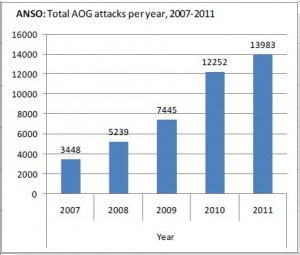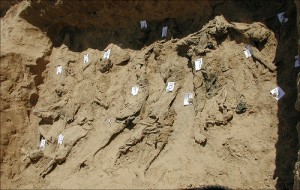Unrepentant War Criminal Dostum Sworn in as Vice President in Afghanistan
The worlds largest vendors of death and destruction, US defense contractors, must be at their highest state of euphoria ever. Last week, they were able to add Syria to the newly expanded list of fronts on which they are vending weapons for US misadventures (after Iraq had recently been brought back onto the list as well). Today, high fives and the clinking of toasting cocktail glasses must be sounding throughout the beltway as the long-awaited swearing-in of the new Afghan President (Ashraf Ghani) has finally taken place this morning. That means that the biggest and longest-lasting source of their bloodstained wealth, Afghanistan, will continue to pay them handsomely for at least a couple more years, as it is widely expected that the Bilateral Security Agreement will be signed tomorrow, keeping the flow of weapons and destruction wide open.
Nearly lost in all the drama of the prolonged “election” process in Afghanistan is that the first vice presidential candidate on the eventually “winning” ticket headed by Ashraf Ghani was Rashid Dostum. Yes, that Rashid Dostum, as described by McClatchy in 2008:
Seven years ago, a convoy of container trucks rumbled across northern Afghanistan loaded with a human cargo of suspected Taliban and al Qaida members who’d surrendered to Gen. Abdul Rashid Dostum, an Afghan warlord and a key U.S. ally in ousting the Taliban regime.
When the trucks arrived at a prison in the town of Sheberghan, near Dostum’s headquarters, they were filled with corpses. Most of the prisoners had suffocated, and others had been killed by bullets that Dostum’s militiamen had fired into the metal containers.
Dostum’s men hauled the bodies into the nearby desert and buried them in mass graves, according to Afghan human rights officials. By some estimates, 2,000 men were buried there.
Earlier this year, bulldozers returned to the scene, reportedly exhumed the bones of many of the dead men and removed evidence of the atrocity to sites unknown. In the area where the mass graves once were, there now are gaping pits in the sands of the Dasht-e-Leili desert.
Dostum and his followers continue to be thugs, adding to tensions last night that led to speculation that Abdullah Abdullah might boycott today’s inauguration (he eventually did show up):
Another bad sign occurred Sunday morning, when Mr. Abdullah’s representatives and those of Mr. Ghani’s running mate as first vice president, Abdul Rashid Dostum, got into a scuffle over office space in the Arg, as the presidential palace here is known, a Western diplomat, who spoke to a witness to the episode, said.
Mr. Dostum is a warlord from northern Afghanistan whose heavily armed followers, wearing civilian clothes, have been much in evidence in Kabul lately.
Mr. Abdullah’s team believed it had been assigned those offices in the Arg for the chief executive officer and his staff, and had already moved in furnishings, when Mr. Dostum’s representatives arrived on Sunday.
“Incredibly enough, they came and cleared them out for Dostum,” the diplomat said, speaking on the condition of anonymity because of the political sensitivities involved.
So while Abdullah has been declared to be the chief executive of Ghani’s government, I would expect Dostum and his thugs to move in on more of Abdullah’s territory than just his assigned office space. With billions of US dollars up for grabs over the next two years, I expect Dostum to waste no time in grabbing all he can while laughing at anyone who would dare to say it isn’t his.


